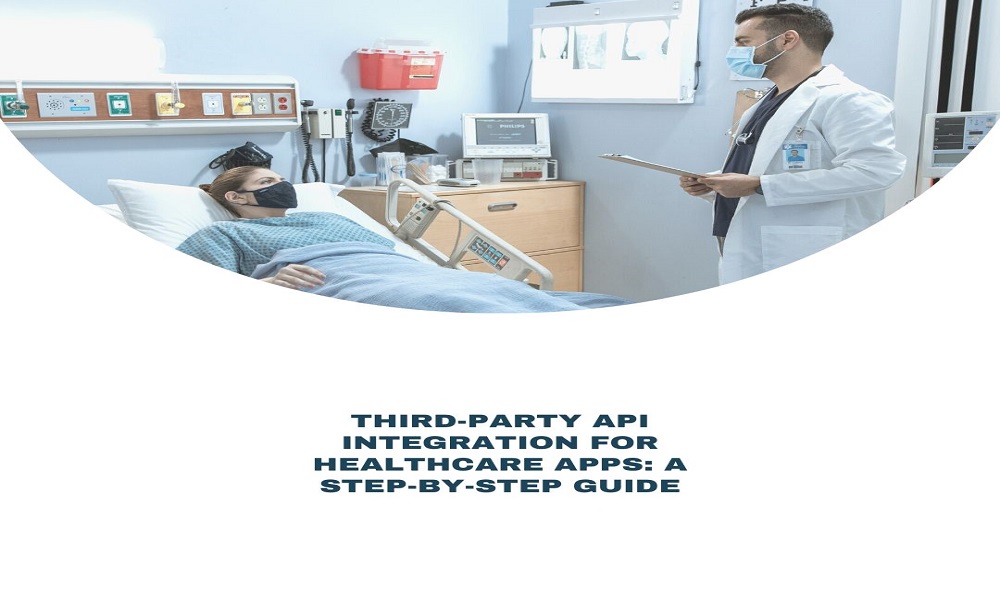How to Implement Third-Party API Integration in Healthcare Apps?
Since 2021, telemedicine solutions have shown a decline in patient satisfaction. The primary reason for this is the lack of services provided by a majority of mHealth techniques. However, given these recent market shifts, it is currently not difficult to raise client satisfaction levels by improving your telemedicine software. API integration is essential for efficient and affordable development.
This article was written to help you understand the API integration process, how it can benefit your telemedicine product, and the necessary stages.
How Can APIs Help Your Mobile App?
1. Remove unnecessary work
Your medical software’s APIs are ready-made tools with a certain set of capabilities. They enable your team to develop the software two times more quickly by eliminating unnecessary manual work that takes hours to do.
2. Keeping Data Securely
For the development of medical software, data security is crucial. APIs are a great option for businesses trying to establish themselves as trustworthy and secure care providers. However, when integrating APIs into a healthcare app, care must be taken to ensure multi-level security and compliance with an array of crucial laws, including HIPAA.
3. Share Medical Data Efficiently
Your mobile application development can arrange secure data transmission through the use of APIs. It enables people to access all of their medical records quickly, share information with the healthcare provider, and receive treatment.
4. Promote innovation
Medical care is accurate and of high quality because it is supported by evidence. To make data easier to access for patients and doctors, these APIs are used by healthcare app developers to create databases. Healthcare businesses will be able to work together and enhance the medical sector.
5. Deliver high-quality service
A wide variety of systems are connected through APIs. It will give medical professionals in-depth knowledge of the problem and past treatments, enabling them to develop more precise treatment regimens.
Case study of a third-party API for your healthcare mobile app
1. 1. Apple Health Records
One of the most widely utilized APIs for developing healthcare apps is this particular one. To encrypt, extract, and aggregate Electronic Health Records (EHR) into a single location, it links more than 500 healthcare systems. Healthcare practitioners will be able to access data in a variety of ways based on iOS devices, including:
- Health essentials
- Existing conditions pre
- Immunizations, allergies, and test results
- All completed and scheduled procedures.
2. Bluestream
Since it enables the integration of virtual appointments, remote booking, and real-time activity tracking of the services they provide, this API is commonly utilized by hospitals and private clinics. Additionally, this API complies with HIPAA security requirements, enabling clinics to provide WebRTC streaming protocol-based HIPAA-compliant video conferencing. The following are included in it:
- Live chat;
- Screen sharing;
- Image capture;
- And one-click joining.
3. PEPID
For telehealth applications and point-of-care information systems, Pepid’s drugs checker API is amazing. Its features enable the development of an in-depth assessment of a patient’s health and treatment. This API’s available features include:
- Identification of pills
- Compatibility with IVs
- Dosage calculator
- Allergy checker
- Lab manual
- And interactions checker.
4. DrChrono
DrChrono provides a collection of APIs for telehealth applications. Patients can schedule and carry out virtual visits from their EHR using apps that are backed by this API, allowing doctors to view patient information in real-time without delaying the appointment.
5. Isabel Healthcare
The Isabel Symptom Checker (SC), which has 96% accuracy in matching symptoms to a table of 6,000+ diseases, is used by healthcare organizations all across the world to improve diagnosis. To encourage patients to engage with a patient portal or an app, this API can be simply implemented to serve as a virtual triage solution.
6. TruePill
Through telemedicine apps, this API enables patients to communicate with their pharmacist. This enables them to learn about the medication that has been provided to them, allergies, interactions, and any potential side effects. By providing a variety of e-prescribing options, the healthcare API develops a connection between patients and pharmacies.
Integrating Third-Party APIs into Healthcare Mobile Apps: Challenges
1. Preventing Unauthorized Data Access
For the majority of clinics and businesses, preventing illegal access to sensitive information remains their top priority. Strong security initiatives, such as authentication and permission procedures allowing users to access just the data they should, are necessary for these apps and APIs.
2. Reliable Audit Trails
Healthcare applications must grasp user data that the healthcare sector is highly regulated. You might need to log every API-based action, depending on the function and API of the app. This must be done in order to audit systems and observe the entire data flow accurately.
3. Data Security Entitlements
Healthcare companies should be clear about exactly who can access data and at what level before creating applications. Data entitlements must be in place for every party having access in the case of a healthcare API.
4. Preventing System Overload
Since the system expands and gets additional implementations over time, integrating APIs may cause it to become overloaded. It would be best if you implemented rules that will manage system load and impose a limit on the number of API requests that can be made.
Health Care Apps Using Third-Party APIs: Pros and Cons
Advantages
1. Greater Interoperability
In spite of the platform or programming language used to create them, APIs are utilized to enable smooth communication between various software systems. This lessens work for healthcare organizations and improves system interoperability.
2. Increased Effectiveness
Development teams can reuse code from current systems due to API-based infrastructures, which speed up business processes and lower costs.
3. Better user experience
APIs enable third-party developers to develop software applications that quickly interface with current software systems, improving user experience.
4. Greater Flexibility
APIs provide greater flexibility by allowing programmers to select the most effective coding languages and frameworks in accordance with their company’s demands.
5. New Streams of Revenue
Organizations can create new revenue streams by allowing other developers access to their software systems by using APIs’ improved functionality.
Drawbacks
1. Security Concerns
APIs have the potential to be very susceptible and lead to data breaches. SQL injection and cross-site scripting (XSS) attacks are the most prevalent forms of attacks that target APIS. Implementing safety protocols is crucial to protect the app against these hazards.
2. Complexity
Some APIs are complicated and demand more expertise. To ensure that the app remains on the right side of the law, they also require a team of developers to implement and manage it properly.
3. Concerns about Compatibility
Additionally, APIs may have compatibility problems with different software versions. They can be difficult to connect various systems, which, if not tested, might result in errors.
4. Dependency on External Developers
Third-party developers are heavily reliant on APIs. This results in system-owning dependencies that are outside the organization’s control. Additionally, this increases the risk of an attack on the software.
5. Management and Governance
To ensure that the majority of current healthcare APIs are utilized correctly, effective governance and administration are required.
Strategies for Integrating Third-Party APIs
1. Carefully go over all API documentation.
The functionality of the API cannot be utilized without consulting its documentation. API documentation is a useful resource that provides crucial details about implementation, such as usage restrictions, data input and output, and other implementation specifics.
2. Choose Reliable and Validated APIs
Some APIs have a significant risk of downtime since they rely on outside services, according to a study. And the risk increases each time these same APIs are not tested or are poorly maintained. When using low-quality APIs, this results in poor user experience and can even result in revenue loss in the case of a data breach.
3. Audit your APIs for vulnerabilities in security
The previous point is related to this one. High-security levels of safety and encrypted connections are features of several APIS. Some are neglected, making them vulnerable targets for hackers. Make sure the APIS your healthcare app will interface with is safe against common security concerns and data theft.
4. A company should scale with APIs
Make sure the API you choose can grow with your user base since this is a crucial factor to take into account while making your decision. You don’t want to constantly shift third-party services as your business expands because APIS may overload the system and lead to a variety of problems.
Conclusion
With years of experience creating safe, dependable, and scalable mHealth and telemedicine systems, Flutter Agency is an outstanding provider of healthcare development services. We provide comprehensive end-to-end healthcare app development services which cover every stage of the process. We employ the most healthcare developers of any company on the market, from the planning and investigation phases to the finished compliance apps.
If you want to create a customized healthcare application that is reliable, effective, and secure and integrates third-party APIs, we can help you. Our developers are highly qualified and have years of experience working in that field. We make sure your APIs are correctly developed and regularly maintained.
Frequently Asked Questions (FAQs)
1. What does healthcare API integration mean?
APIs in the healthcare industry will make it simple for patients to switch between services while quickly transferring their data, giving both patients and doctors greater insight than ever before.
2. What are the techniques for integrating APIs?
API integration is the process of using distinct software applications’ APIs to connect them. This enables the interaction of data and functional sharing between these applications, resulting in an integrated and consistent digital environment.
3. How do APIs help healthcare apps?
Companies that integrate APIs into their EHR systems can facilitate patient data collection and sharing. This enhances patient care overall, lessens manual labor, avoids data loss, and creates new business opportunities for clinics.
Contemporary ventures
Recent blog
ready to get started?
Fill out the form below and we will be in touch soon!
"*" indicates required fields









